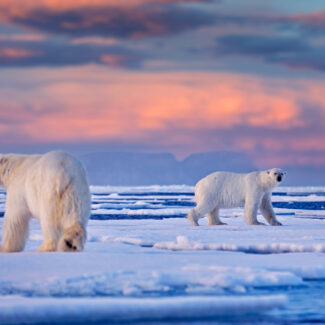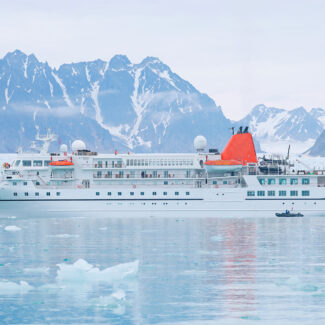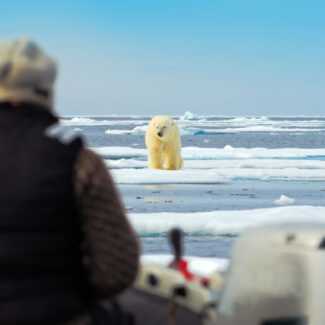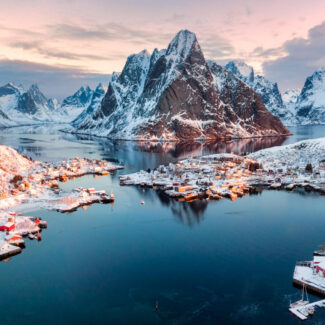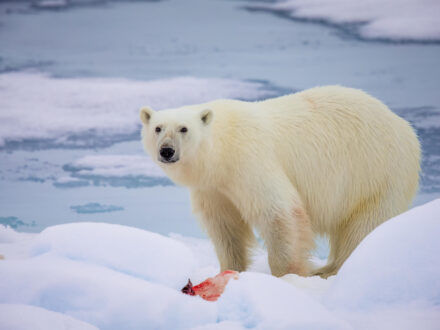7 Fun Facts About Snowy Owls To Wow Your Friends With
- (1) They’re Among the Biggest of All Owls
- (2) Their White Plumage is Unique Among Owls
- (3) They May Take Many Different Kinds of Prey, But Lemmings Are Normally the Dietary Mainstay
- (4) They’re Found Throughout the Arctic in a Single Global Population—and They’re Far-Traveling Nomads
- (5) They’re One of the Few Owls to Actually Construct Their Nests—and They May Festoon Them With Dead Lemmings
- (6) They May Winter in the Arctic or Travel Far South
- (7) They Show Up in Prehistoric European Cave Art
- Where to See Snowy Owls
No owl ranges farther north than the marvelous snowy owl, one of the most impressive birds in the world and as much an icon of the Arctic realm as the polar bear. This spectacular avian predator—the fabled “white owl” of the tundra and sea ice—sits at the top of the food web and thereby helps control and moderate populations of such common prey as lemmings.
For this article, we’ve rounded up seven of the most fascinating and illuminating snowy owl facts—read on for insights into this regal and fiercely fine-tuned hunter of the Arctic barrens!
(1) They’re Among the Biggest of All Owls
Generally weighing three to five pounds and boasting a wingspan that may exceed five feet, the snowy owl is a hefty bird of prey indeed. It’s on average the heaviest or perhaps “co-heaviest” of North American owls, being broadly comparable in mass to the great horned owl; it’s outweighed, meanwhile, by a number of Old World owls, including the Eurasian eagle-owl and the Blakiston’s fish owl.
It’s also on average larger than that other great apex avian predator of the Arctic, the gyrfalcon, though there’s definitely some size overlap.
As in most raptors, it’s the female snowy owl that’s the bigger—by a fair measure—of the two sexes.
With their imposing size and magnificent wingspan, Snowy Owls are among the largest and most powerful owls on Earth. Don’t let their pristine white appearance fool you; these formidable hunters are perfectly adapted to the Arctic tundra, inspiring awe with their silent, commanding presence.
(2) Their White Plumage is Unique Among Owls
No other owl has a feathered coat quite like the snowy, which is, arguably, the most strikingly colored of its kind. Adults are primarily white-colored all year-round, providing the perfect camouflage against the snow-covered landscapes of the Arctic tundra.
The male wears the purer tone, being mostly all white save for some minimal black markings on the wingfeathers and sometimes other areas; female snowy owls have much heavier brown to black barring, though the face and chest tend to be mostly or wholly white.
Males may take a number of years to mature into that nearly pure-white plumage, with immature individuals resembling female snowy owls.
With their breathtaking, almost entirely white plumage, Snowy Owls are truly unique among their owl kin, offering perfect camouflage in their Arctic home. This striking adaptation makes them master hunters of the frozen tundra, inspiring awe for nature’s exquisite design and the incredible beauty found in the most extreme environments.
(3) They May Take Many Different Kinds of Prey, But Lemmings Are Normally the Dietary Mainstay
From eiders and ptarmigan to Arctic hares, Arctic-fox kits, and even fish, snowy owls are known to take a wide variety of prey in their normal Arctic haunts—and pursue an even more varied diet when wintering at lower latitudes, such as the southern Canadian prairies and sites in the Lower 48 of the United States. There, the owls may feed heavily on waterfowl, jackrabbits, mice, voles, grouse, pigeons, and many other sundry creatures.
But the number-one linchpins of the snowy owl diet in most of its range, and particularly during the breeding season, are lemmings. Indeed, the abundance and density of lemmings appears to be a determining factor for many snowy owls with regard to where they nest, and peaks in lemming population result in accordingly larger-than-average snowy-owl broods. In Scandinavia and in Greenland, irregular snowy-owl breeding seems correlated with the boom-and-bust cycles of lemmings. While research in Greenland and Nunavut suggested that snowy owls bred at a minimum density of about two lemmings per hectare, a study on the Taimyr Peninsula of Siberia found that owls only nested when the lemming density hit 11 per hectare. One owl family may throw back 1,500 or more lemmings across the course of the breeding season!
Snowy owls often hunt by scanning from an elevated perch or flying low over the ground to pounce upon rodents and other fare. They’ve even been known to pursue prey in a running fashion.
While incredibly versatile hunters capable of catching diverse prey, Snowy Owls primarily rely on lemmings for sustenance. These Arctic masters, like the one poised here, demonstrate a fascinating dietary specialization that highlights the intricate balance of the tundra ecosystem. Their adaptability and crucial role in the food web are truly inspiring.
(4) They’re Found Throughout the Arctic in a Single Global Population—and They’re Far-Traveling Nomads
Snowy owls are a circumpolar species, found throughout the Arctic: from Scandinavia and Russia through western and northern Alaska, the Canadian High Arctic, and northern Greenland. They are only a fleeting, occasional presence in Iceland. The connectivity of their range and their impressive long-distance flight capabilities mean that the global snowy-owl population is essentially a single, contiguous one.
When seeking high densities of lemmings to select optimal nesting grounds, and during their far-ranging wanderings outside of the breeding season, snowy owls commonly travel from, for example, Scandinavia into Russia, or between Russia, Alaska, and the Canadian Arctic Archipelago.
Snowy Owls are true Arctic nomads, embodying the spirit of wilderness and adaptability. These far-traveling birds traverse vast distances across the global Arctic, inspiring us with their resilience and reminding us of nature’s boundless beauty and the interconnectedness of our planet.
(5) They’re One of the Few Owls to Actually Construct Their Nests—and They May Festoon Them With Dead Lemmings
While many owls utilize tree cavities or co-opt the nests of other birds for theirs, snowy owls actually construct their brooding sites: The female owl will dig out a bowl-shaped depression in the tundra within which to lay her eggs (usually five to 10 per clutch, though the number may be significantly more in a good lemming season). These nests are often situated up on ridges, hummocks, and knolls, where wind scours away snow, favorable slope aspect encourages early spring melt-off, and the high ground gives the nesting owl a broad panoramic view.
Female owls lay eggs asynchronously, every few days or so, so nest-mates are commonly of varying ages. While the mother broods her clutch and tends to nestlings, the father stays busy hunting for the family, and it’s not uncommon to find snowy-owl nests literally ringed with heapfuls of killed lemmings: anywhere from 20 to 70 or more.
The father owl is also a fierce defender of the nesting area, readily dive-bombing just about any critter that strays too close—humans included. Even such formidable beasts as Arctic wolves may be harassed in this manner.
Unlike most owls, Snowy Owls are skilled nest-builders, meticulously crafting their ground nests from tundra vegetation. This image shows their industrious nature as they prepare their home. Their dedication to creating a secure breeding site is truly inspiring, highlighting the resourceful instincts of these Arctic birds.
(6) They May Winter in the Arctic or Travel Far South
We already explained that snowy owls are migratory; technically speaking, they’re classified as “irruptive migrants,” which means they may irregularly occupy areas, sometimes in large numbers, in a particular season, then be absent or rare there for years after. Most people who’ve seen a snowy owl in the wild have done so well south of the species’ usual, remote Arctic stomping grounds, as the bird may be found overwintering in much of Canada, and small numbers regularly show up down in the northern conterminous United States. In Eurasia, similarly, snowy owls sometimes turn up in the British Isles in wintertime. During major “irruptions”—which may reflect “boom” breeding years associated with high lemming populations and producing large numbers of fledglings—goodly numbers of snowy owls may show up in these temperate latitudes, often seeking out open country: prairies, meadows, lakeshores, seacoasts, and the like.
But many snowy owls simply spend the winter up in the Arctic, often along the coastline and sometimes, it seems, way out on the sea ice. Getting by just fine in the round-the-clock darkness of that time of year, such owls seem to seek out leads and polynyas in the ice pack, presumably targeting these open-water oases to prey upon seabirds.
Snowy Owls are adaptable nomads, either braving the Arctic winter or embarking on impressive journeys south. Their striking beauty and resilience, perfectly captured in this close-up, highlight their remarkable ability to thrive in diverse, often extreme, environments.
(7) They Show Up in Prehistoric European Cave Art
During the glacial periods of the Pleistocene, tundra habitat extended much farther south than it does today, and thus the snowy owl was apparently a regular denizen of mid-latitude environments. We know this not only from fossils and bones, but also the depiction of this charismatic species in Upper Paleolithic and Mesolithic cave art from Europe. Multiple caves in France show depictions of what appear to be snowy owls, including some dating back more than 30,000 years. By some accounts, these are the most venerable pieces of prehistoric art anywhere that depict a recognizable type of bird. Early humans in Europe appear to have hunted and consumed snowy owls.
Snowy Owls have captivated humanity for millennia, even appearing in prehistoric European cave art. This enduring fascination, reflected in their striking appearance as seen here, highlights their iconic status and the deep connection between humans and these magnificent Arctic birds throughout history.
Where to See Snowy Owls
Few Arctic animals are so utterly thrilling to spy than a snowy owl, though they’re not necessarily easy to see. Arctic cruises to Greenland, the Canadian High Arctic, and Svalbard as well as trips to Alaska, Russia, and Scandinavia give you at least the chance to luck out with a sighting of one of the Arctic’s heraldic predators.
Meanwhile, from England to the American Midwest, residents of lower latitudes have at least the occasional opportunity to periodically spot wintering individuals, especially during those large-scale snowy owl irruptions that tend to be well-covered in media. It’s not unusual for such southerly snowies to be seen even in urban environments, so long as conducive habitat and prey exist.
Disclaimer
Our travel guides are for informational purposes only. While we aim to provide accurate and up-to-date information, Antarctica Cruises makes no representations as to the accuracy or completeness of any information in our guides or found by following any link on this site.
Antarctica Cruises cannot and will not accept responsibility for any omissions or inaccuracies, or for any consequences arising therefrom, including any losses, injuries, or damages resulting from the display or use of this information.




